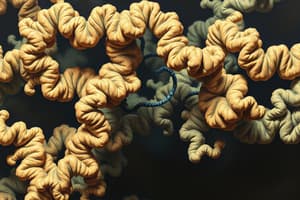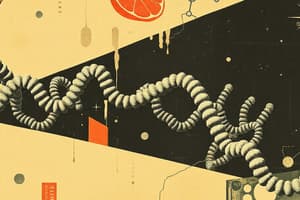Podcast
Questions and Answers
What is the primary building block of proteins?
What is the primary building block of proteins?
- Amino acids (correct)
- Nucleotides
- Monosaccharides
- Fatty acids
What percentage of body composition does protein typically represent in adults?
What percentage of body composition does protein typically represent in adults?
- 30-35%
- 12-18% (correct)
- 20-25%
- 5-10%
Which amino acid classification is associated with a negatively charged group?
Which amino acid classification is associated with a negatively charged group?
- Acidic amino acids (correct)
- Neutral nonpolar amino acids
- Essential amino acids
- Basic amino acids
How many different types of amino acids are recognized as common in protein synthesis?
How many different types of amino acids are recognized as common in protein synthesis?
What type of bond connects amino acids to form proteins?
What type of bond connects amino acids to form proteins?
Which of the following describes a polypeptide?
Which of the following describes a polypeptide?
What characterizes the primary structure of a protein?
What characterizes the primary structure of a protein?
Which type of amino acid is hydrophobic and interacts poorly with water?
Which type of amino acid is hydrophobic and interacts poorly with water?
Flashcards
Protein
Protein
Large macromolecules made of amino acids.
Amino acids
Amino acids
Monomers that form proteins; 20 types exist.
Peptide bond
Peptide bond
Covalent bond joining amino acids in proteins.
Dipeptide
Dipeptide
Signup and view all the flashcards
Polypeptide
Polypeptide
Signup and view all the flashcards
Hydrophobic amino acids
Hydrophobic amino acids
Signup and view all the flashcards
Primary structure
Primary structure
Signup and view all the flashcards
Essential amino acids
Essential amino acids
Signup and view all the flashcards
Study Notes
Protein Structure
- Proteins are large macromolecules made of carbon, hydrogen, oxygen, and nitrogen, and sometimes sulfur.
- Adult human bodies contain 12-18% protein by weight.
- Proteins have four levels of structural organization.
Protein Functions
- Proteins form the structural framework of tissues like bone and connective tissue.
- They act as enzymes, catalyzing biochemical reactions (e.g., salivary amylase, sucrase, and ATPase).
- Proteins serve as hormones and neurotransmitters. Some examples are the hormone insulin and the neurotransmitter substance P.
- Proteins provide support and protection aiding in the body's response to foreign substances and pathogens such as antibodies.
- Some proteins, such as myosin and actin, are involved in muscle contraction.
- Proteins act as carriers carrying vital substances such as hemoglobin which carries oxygen.
Amino Acids
- Amino acids are the monomers (building blocks) of proteins.
- There are 20 common amino acids.
- The liver synthesizes 10 of these.
- 10 amino acids are considered essential as they must be consumed through diet.
Amino Acid Structure
- Each amino acid has an amino group (NH2), a carboxyl group (COOH), a hydrogen atom (H), and a variable side chain (R group) attached to a central carbon atom.
Levels of Protein Structure
- Primary Structure: The linear sequence of amino acids connected by peptide bonds.
- Secondary Structure: The regular sub-structures (e.g., α-helices and β-sheets) of the polypeptide chain stabilized by hydrogen bonds.
- Tertiary Structure: The three-dimensional shape of the polypeptide chain resulting from the folding of the secondary structure.
- Quaternary Structure: The arrangement of multiple polypeptide chains to form a functional protein.
Polypeptide Chains
- Dipeptide: Two amino acids
- Tripeptide: Three amino acids
- Peptide: 4-9 amino acids
- Polypeptide: 10 or more amino acids
Classification of Amino Acids
- Amino acids are classified based on their interaction with water.
- Neutral nonpolar: Hydrophobic (interacts poorly with water) – No charge
- Neutral polar: Hydrophilic (interacts with water) – No charge
- Acidic: Charged negatively
- Basic: Charged positively
Differences in the Function of Proteins
- Various protein shapes result in different functions.
- The kinds and number of amino acids in the chain dictate the function.
Protein Metabolism
- Metabolism is the sum of all chemical processes.
- Catabolism breaks down complex substances into simpler building blocks.
- Anabolism is the building of complex substances from simpler ones. Digestion is an example of catabolism breaking down proteins in food into constituent amino acids which then are used in anabolism (building up) the body's protein structure.
Studying That Suits You
Use AI to generate personalized quizzes and flashcards to suit your learning preferences.




